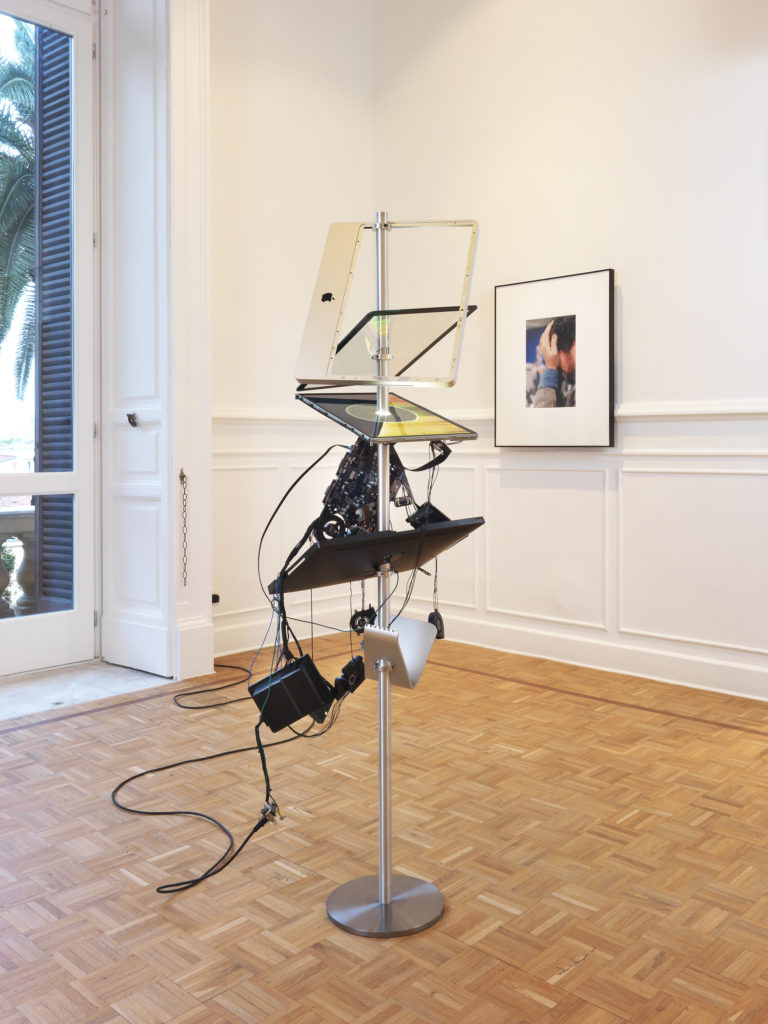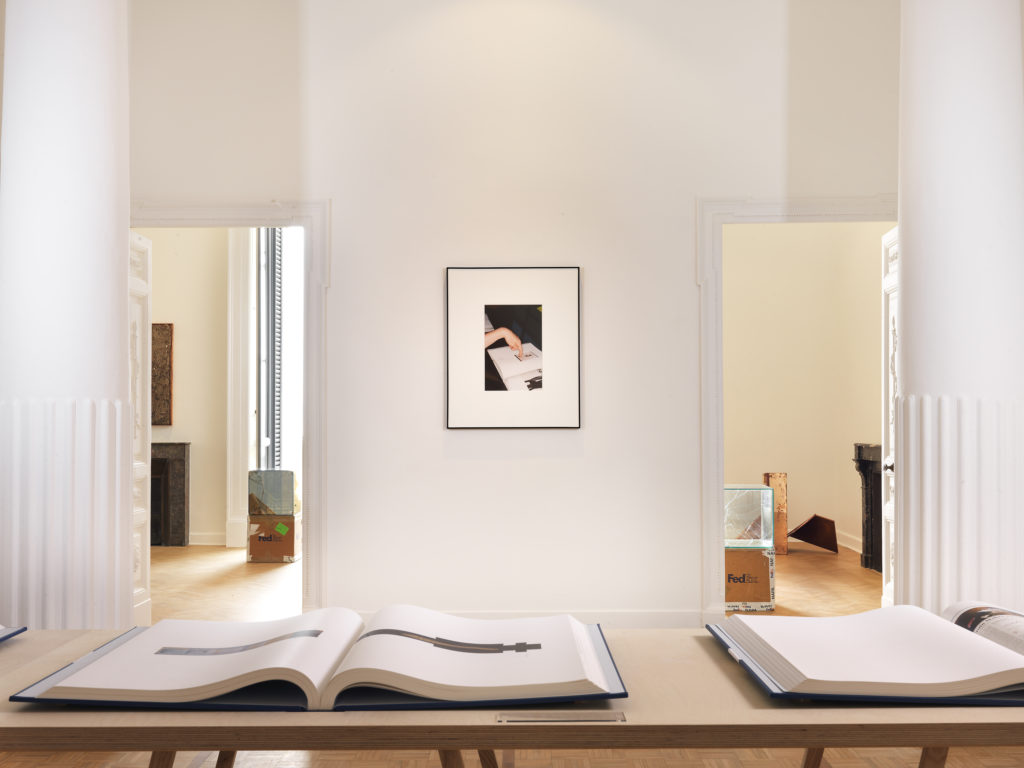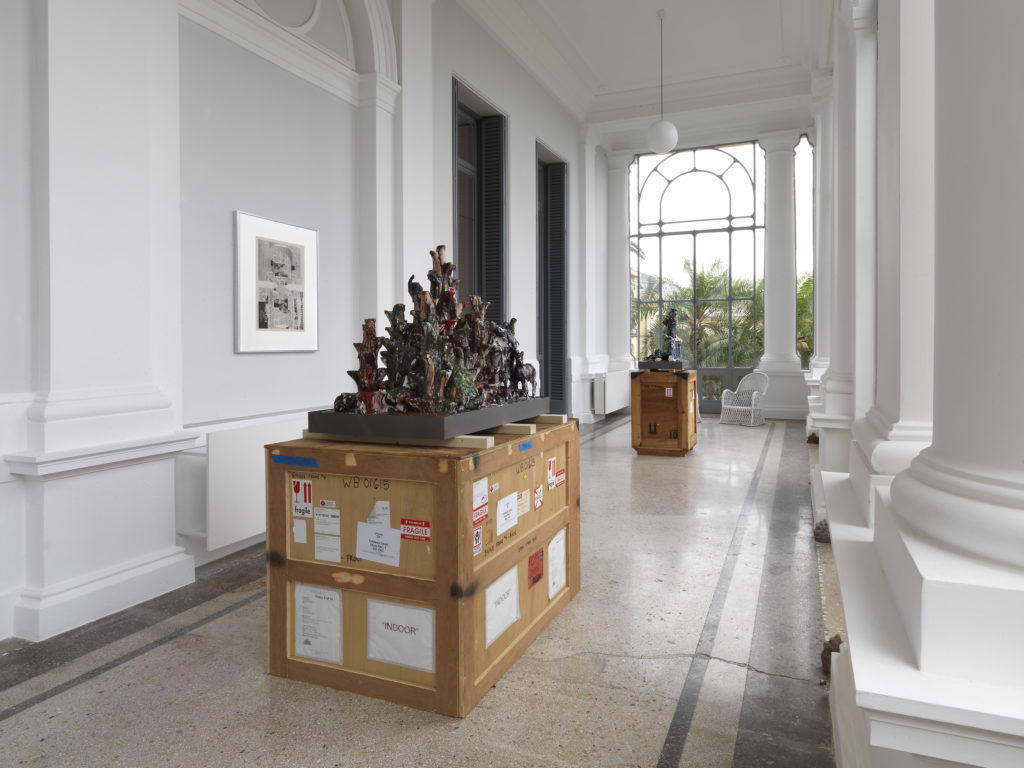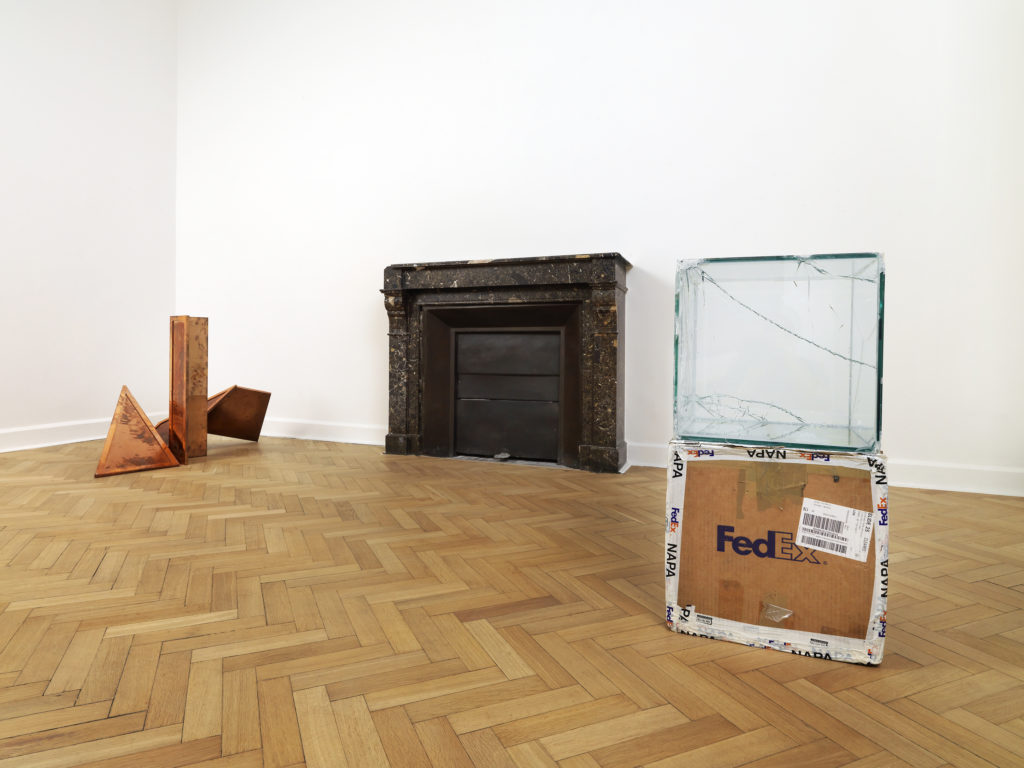Walead Beshty: In Conversation
by Natalie Hegert
In Walead Beshty’s work, the means of a work’s production—the various material transformations and transferences that it undergoes, even its transportation—becomes central to the work itself. In the 2008 Whitney Biennial, Beshty displayed prints from negatives that had been exposed to X-ray as they passed through airport terminals, thus bearing, in a material way, the imprint of international travel, as well as glass boxes, sized exactly to their FedEx shipping boxes, that registered the bumps and bangs of their handling as they moved from one place to another in cracks in the glass. The processes employed in these bodies of work are still ongoing in Beshty’s practice.

In the ten years since, Beshty has continued to focus on the invisible hands behind the production and display of his own work. He creates copper “surrogates” to replace workspaces and tabletops in galleries to record the accumulations of movements and patterns of use in the tarnish of their surfaces. He takes “industrial portraits” of the various actors that make up the art world, from art handlers to museum presidents. Beshty’s practice also makes use of studio scraps as raw material for new works—he compiles and packs shredded, discarded prints into copper frames in the series Selected Works; arranges cast-off ceramics and slip cast remnants from a ceramics studio in Guadalajara, Mexico together in new compositions; documents the tools of his studio in cyanotype prints he makes on scraps of paper—a high-minded sort of recycling.
Beshty’s current exhibition at the Thomas Dane Gallery in Naples is entitled Aggregato, which is fitting for a couple of reasons. It contains an aggregate sample of several strains of Beshty’s most well-known projects—his FedEx boxes, photograms, copper surrogates, ceramics—and it points to the underlying principles of Beshty’s practice in its emphasis on reuse and accumulation.
A diligent and renowned researcher, writer, and curator, Beshty’s curated exhibition Picture Industry: A Provisional History of the Technical Image, 1844–2018, presented at CCS Bard last year, is currently on view at Luma Foundation in Arles, which recently released the accompanying publication, an impressive—though, he assures me, not definitive—tome of images and writings on the mechanically reproduced picture.
In the following interview, we discuss the place of process and parameters in his projects, the ongoing nature of most of his art practice, and his dedication to showing the material nature of the things that many consider “immaterial.”
Natalie Hegert: In producing your works, you rely on predetermined systems and processes. In the photograms, folds, loops, and curls are produced—blind—in the darkroom, following a particular process, but the finished works are undeniably beautiful. What, then, is your relationship to beauty?
Walead Beshty: Beauty as a term is rather muddy conceptually, at least in my experience. It’s defined rather mundanely as aesthetic pleasure, although the particular quality of this pleasure is ambiguous. I am not particularly interested in the Kantian notion of beauty (disinterested, universal, necessary, purposive without purpose)… That is not to say I do not think pleasure is important, quite the contrary, I think pleasure is central to our experience of the world, to what it means to be a living thing. The form of aesthetic pleasure that I find the most compelling arises from new or novel combinations of elements that extend or complicate the knowledge of the world we gain through our senses; it is a novelty or newness of experience that arises from the unexpected application of the conventions of aesthetic communication. So, it is continuous with convention, but leads to something that one would not expect from those conventions, it expands a preexisting logic to allow for experiences that weren’t available before. I also think that this idea of pleasure has to do with a possibility for extended engagement, that this pleasure arises from the experience of a deeper connection to the things and the people around us. In that sense, aesthetic pleasure is a political issue for me, that the beautiful, or the form of beauty I am interested in, allows for a greater engagement with the world, of an opening up of the way experience is available to us via the senses, both the experience of things, but how things can facilitate a greater engagement and connection to other human beings. But beauty is difficult as a concept, because even the ugly or off-putting can offer aesthetic pleasure, especially when defined in the manner I have put forward above. In general, I do not place much weight on the concept of beauty in and of itself, taste perhaps is richer for its sociological implications, but beauty is a term that is only provisionally useful for me. As a conceptual tool, I find it antiquated and difficult to make applicable to the contemporary. It is too vague and I think, misleading.

NH: A number of your bodies of work are ongoing series that continue to be produced. Following the parameters of these projects, you’ve said “I continue something until I am unable.” I’m interested in the process by which certain series are brought to a close and others remain open-ended. Can you talk a bit about that?
WB: My work is always tethered to the conditions which make it possible, and by design these conditions are often outside of my control. In the past I have thought about this as using readymade systems of production, of using preexisting systems—which operate in their own right, with their own agendas—to alternate ends. Ending a body of work authoritatively, based on my own impulses, would shift this emphasis—it would imply the significance of the work resides with my executive authority over it, which contradicts the reasons why I’m engaged with art in the first place. In other words, it’s less about decoding or speculating about my decision making than the work being a tool or approach to facilitate a certain understanding of the world. My own considerations, the way I construct the work, is part of it. This, I think, is somewhat unavoidable, but this is not the reason I produce things and isn’t the primary concern of the work. I try to actively imbed this decision making into the work, make it continuous with the other conditions the work navigates. I consciously set up my practice so that the questions that arise (why does it look a certain way, why was it initiated, why did it come to a close) point to broader conditions than simply my own personal desires. So, for example, the transparencies (works made by putting unexposed film into my checked baggage) will continue until one of the variables are no longer in play. Either the film stops being made, or the technology of the TSA changes, or I, for some reason, am not required to travel as part of my professional life. By simply continuing the work until one of its main variables makes it impossible to do so, it allows the work to do things I had not foreseen. Rather than stopping at some outcome or another, it continues beyond my expectations for it, to the point where it finds its own conclusion.
NH: Your copper surrogates remind me of Gabriel Orozco rolling a clay ball through the city and recording the impressions of the street, but even more so they remind me of a bar I like to go to in Colorado Springs that still has its original formica countertop, worn smooth in certain spots in front of each bar stool where people have put their elbows and their drinks for decades. What do your copper surrogates tell us about these surfaces, the people who use them, and the activities that are performed on and around them?
WB: The bar is a nice example of what I think is compelling about all aesthetic objects: that meaning/appearance (and our experience of a thing) is the result of a process of accrual; that meaning arises from the accrual of uses people put a thing to, whether material, as in the tarnishing of a surface, or symbolic, such as the use of a particular thing in various contexts which creates different implications—say the multiple uses a national flag might be put to, as a nationalist emblem, as a figure of protest or parody, and so on—and how that informs the ways we see that object; that each experience of the object is an experience of these varied deployments of that thing we’ve experienced. An object threads together all these disparate deployments; it acts as a node through which a multitude of uses and applications flow.
The copper surrogates were a way to materially incorporate part of this idea, the multitudes of different forms of work required, such as the invisible labor involved in the production and display of a work, from the work of the gallerists or attendants discussing the work across its surface (in the case of the table tops), or the labor involved in the handling, installation, and deinstallation of a work (in the case of the free-standing forms). In either instance, it is the invisible labor, the work that goes unseen within an exhibition space, which I wanted to make present on the material surface of my work. More than that, this labor “produces” the work in the sense of constructing how it is experienced, which is inextricable from the thing itself, so it was a way to visually imbed these activities into the thing, make them visibly intrinsic, inseparable from the appearance of the thing. While the reflective surfaces of the surrogates cast an image of their surroundings back at the viewer—including the body of the viewer, the space—the tarnishing presents a temporal accrual of physical investment in a thing, the labor invested in making the thing public, visible, and available to an audience.
NH: If I were to document each of the objects and tools in my studio, like you did with the project A Partial Disassembling of an Invention without a Future: Helter-Skelter and Random Notes in which the Pulleys and Cogwheels are Lying around at Random All over the Workbench, I would probably first reach for my phone. Instead you made cyanotypes of all these objects, totaling almost 12,000. Why is it that you chose the cyanotype as the medium for this indexical exercise?

WB: There are a number of ways to explain this. I suppose the simplest explanation was that I wanted to use the discarded material from the studio as the material support of its own representation. It is the byproduct of work and the representation of that byproduct, not to mention that the byproduct is the work itself. Cyanotype has historical resonances, as it was a very early form of the photograph, and had applications in both science, technical printing (such as blueprints), and art, but at its most basic level, it uses a simple and easy to use chemical, potassium ferrocyanide, which binds to any cellulous-based material. Most of the waste from the studio is of this type: paper, card board, wood, etc. So, upon one form of waste, the other wasted and exhausted objects could be imaged (such as broken tools, and various other detritus). It tended to skew that the substrate, the cellulous, often contained text, such as emails, letters, gallery announcements, prescriptions, bank statements, and so on… So, these were often narrative descriptions of the production process, albeit fragmentary and sometimes obscure. In a way, it was to make an exhibition which accounted fully for its own making, whose making was inextricable from the thing itself, which incorporated the life of the studio as a productive mechanism.
NH: Many of your works set out to reveal the materiality of artistic production, logistics, and labor that is often hidden, for example in the FedEx series and your portraits of art world workers. As so much of art production and art viewing, particularly in photography, is moving to digital and online experiences, what are your thoughts are on the internet as a material? It goes against the popular conception of the digital realm as this entirely immaterial thing, but, for instance, I think it’s interesting to think of these massive rooms of servers and how internet searches are conducted through transatlantic undersea cables.
WB: I would not say my works reveal anything, rather I just try to not conceal. I do not think the labor or logistics involved in art production is a revelation, but rather an aspect of all art, or aesthetics for that matter, an aspect which is often actively concealed but is always present whether we acknowledge it or not. We experience artworks in exhibition spaces, or in reproduction, but all the work required to put these things into those contexts is obscured. It seemed there was potential for a better understanding of what was at stake within aesthetics in trying to actively use this unaccounted-for labor, to acknowledge it and allow the work to index it. In a way, I think it is a very conventional move, a logical extension of a dominant lineage in art making of acknowledging or using the support of a work within the work itself—such as Brancusi absorbing the plinth into his work, or Duchamp emphasizing how discourse, e.g. naming, affects the meaning and experience of an object, through to someone like Michael Asher or Andrea Fraser, incorporating various aspects of the context into the work, whether that be the architectural support or the social discourse around it. In that way, making the labor involved in transporting, discussing, and displaying an artwork visible or experienceable in some way seemed a logical step…
Regarding the second part of your question, there is this fantasy of dematerialization that pops up whenever new technologies arise. The discussion of the internet is being subject to the same fantasies. People used to say the same of photography, that it was somehow immaterial, free-floating, de-materialized in some way, that the world had become mere appearance, turned into a circulation of images, untethered from place, wholly portable and ephemeral (which ignores the massive industry and fixed chains of distribution required to support such a system). It is no less false for the Internet, but perhaps it is more insidious, as the reach of the Internet is wider: more hierarchical, and more centralized, with its massive infrastructures, availability to corporate and governmental surveillance, and barriers to entry (the sheer expense and infrastructure needed to access it is huge—a computer, stable communication lines, power grids, etc.). By obscuring these facts, one ignores both the possibilities of these systems of communication—in seeing them as transparent or seamlessly ubiquitous we conceal the ability of individual users to tinker within them in unprescribed ways—and the consequences of our activities—the material effects of these communications on the way we comprehend each other, or the harms, such as the tonnage of discarded computer equipment we ship to impoverished nations, the environmental impacts of massive power-hungry server farms and the telecommunication systems they are integrated with. In this sense, the dematerialization argument lets us off the hook, it makes us less responsible for the impacts of our actions on the world, and thus turns a blind eye to the real transformations of the lives of those that work with and within those systems.

NH: Can you tell me a bit about how you approached Picture Industry: A Provisional History of the Technical Image, 1844–2018 as an exhibition and as a book?
WB: The project began with an invitation from Liam Gillick to organize one of four artist-curated projects contained within the exhibition Systematically Open? New Forms for Contemporary Image Production (2016) at the Luma Foundation in Arles. I then was invited by Tom Eccles to expand the exhibition several fold for the Hessel Museum at Bard College, which also provided the context to begin working on a publication. Finally, the book was published in conjunction with a final installation of the exhibition back at Luma. Both ended up being more ambitious and expansive than I had foreseen, the book particularly so, coming in at almost 900 pages… The idea behind the show, and the relatively short time line, meant I was always trying keep up with the movement of the ideas. The whole project dominated my professional life over the past 3 years, and really was the culmination of a thought process that began in the mid-2000s. I discuss this in the introduction, so I won’t rehearse it here, but the project was an attempt to reconceptualize a number of discrete histories into something more expansive and intertwined.
Initially, I was interested in making a historical exhibition that dealt with the circulation and material specificity of technical images, a broad term coined by the Czech media theorist Vilém Flusser, which chiefly deals with mechanical or automatically produced images, inclusive of photography, print making, cinema, video, and so on. I preferred this term because it allowed for a mapping of the intertwined histories of mechanical images (the X-ray, photograph, cathode ray tube, cinema, offset print, lithography, etc. have interrelations that no medium based distinctions native to art history or the museum really could address, moreover these distinctions are often arbitrary), and also reached into the complex of related uses of these images, from scientific research, to governmental projects, journalism, art, and so on. It also allowed me to use a broader organization of social life, whether economically or politically, as an organizational principal. In short, because technical images always have a relationship to economies of scale, to industrialization, to war, to social change, to the concrete means by which images or depictions trafficked in real terms, from production to reception, it allows us to see how broader societal developments were framed through the image traffic of their times, and to see the material existence of images as a result of the societal changes they also depicted.
By its conclusion, the exhibition consisted of more that 300 objects from over 90 unique producers. The book was conceived as an anthology of writings and reproductions spanning the same time period (1844–2018), which had its own logic and progression independent of the exhibition. Of chief importance to me was that the publication have a use beyond the exhibition—it was also an opportunity to make out-of-print or obscure texts and images available to an audience and recontextualize some better-known seminal pieces of writing or images. The aspiration is that both the exhibitions and the book would have their own lives, intertwined of course, but each capitalizing on the qualities of their respective contexts, whether, in the case of the exhibition, it is a historical argument that unfolds within architectural space presenting a history as something experiential, material, and phenomenological, or in the case of the book, a portable, more linear, methodologically focused, narrative. In each instance, I felt it important to emphasize the provisionality of the relationships between its constituent parts, that the project represents one historical arrangement among a multitude of possible equally viable historical arrangements. In other words, I did not want to produce a definitive history, but a set of relations that unfolded historically but could be subject to myriad substitutions or rearrangements. Hence the foregrounding of the word “provisional” within the title.
Walead Beshty (b. 1976, London, UK) is an artist and writer working in Los Angeles. He has had solo exhibitions at such institutions as the Barbican Centre, London; Ullens Center for Contemporary Art, Beijing; Malmö Konsthall, Sweden / Centro de Arte Dos de Mayo, Madrid; The Hirshhorn Museum, Washington D.C.; Hammer Museum, Los Angeles; and P.S.1 Contemporary Art Center, Long Island City. Beshty’s work is held in permanent museum collections worldwide, including the Guggenheim Museum, New York; the Museum of Contemporary Art, Chicago; the Museum of Contemporary Art, Los Angeles; the Museum of Modern Art, New York; the Tate, London; and the Whitney Museum of American Art, New York, among others. Beshty has organized exhibitions at such institutions as Luma Arles, France; the Hessel Museum, Center for Curatorial Studies, Bard College, Annandale-on-Hudson, NY; the Rose Art Museum, Brandeis University, Waltham, MA; and P.S.1 Contemporary Art Center, Long Island City, NY. Monographs on his work include Walead Beshty: Natural Histories (JRP|Ringier, 2011; second expanded edition, 2014) and Walead Beshty: Selected Correspondences 2001–2010 (Damiani Editore, 2010). Beshty edited the anthology Ethics, in Whitechapel’s Documents of Contemporary Art series (MIT Press, 2015), and Picture Industry: A Provisional History of the Technical Image, 1844–2018, (JRP|Ringier, 2018). His collected writings 33 Texts: 93,614 Words: 581,035 Characters: Selected Writings (2003–2015) was published by JRP|Ringier, 2016. His work is represented by Regen Projects, Los Angeles; Petzel Gallery, New York; Thomas Dane Gallery, London; Galerie Rodolphe Janssen, Brussels; and Galerie Eva Presenhuber, Zurich.